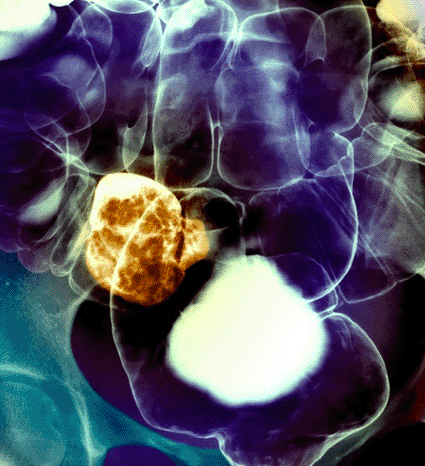Photodynamic Diagnostic System Shows Potential in Identifying Colorectal Cancer Lesions
By Labmedica staff writers
Posted on 27 Feb 2008
Posted on 27 Feb 2008

Image: Colored frontal x-ray of the large intestine of a patient with cancer of the sigmoid colon (Photo courtesy of Zephyr / SPL).
The new fluorescence-based photodynamic diagnostic (PDD) product, named Lumacan, was developed by Photocure ASA (Oslo, Norway) to improve conventional colonoscopy in patients with suspected colorectal cancer. This new product is based on its Hexvix product, which is already approved in Europe for the improved diagnosis of bladder cancer lesions.
Patients with suspected colorectal cancer are routinely examined by visual inspection of the colon (colonoscopy). The entire colon is examined to find tumors and polyps, however, this approach is effective in identifying fewer than 80% of lesions, and those missed may progress to colorectal cancer.
Photocure has performed a dose-finding phase I/II study at two hospitals in Germany using its PDD product in 32 patients with suspected colorectal cancer. Patients received local instillation of the photosensitive compound hexaminolevulinate (HAL) in the colon before proceeding with standard colonoscopy using both white and blue light. HAL is rapidly accumulated in metabolically active cancerous and precancerous cells and fluoresces red when illuminated with blue light.
The results from the first 12 patients have now been published in the February 2008 issue of the journal Endoscopy by Dr. Brigitte Mayinger, Hospital Munich-Pasing (Munich, Germany), the principle investigator of the study. Utilizing histologic findings as the gold standard, 52 of 53 (98%) of premalignant/malignant lesions showed red fluorescence under the PDD examination and 38 of 53 (72%) lesions were detected with white-light endoscopy. Photocure's PDD approach, therefore, located 28% more polyps than identified with standard white-light endoscopic imaging.
No systemic or local side effects related to the use of HAL are reported. Patient recruitment for this trial was completed at the end of November 2007, and the full data from the study is currently being analyzed. Dr. Mayinger stated, "administration of HAL enema induces selective lesion fluorescence and increases the lesion detection rate in patients with colorectal adenoma and early carcinoma.”
Photocure is a pharmaceutical company that develops and markets pharmaceuticals and medical devices based on proprietary photodynamic technologies. Photocure has two products with sales and marketing approvals: Metvix, which is a product developed for the treatment of skin cancer (basal cell carcinoma) and pre-cancerous skin lesions (actinic keratosis), and Hexvix, which is developed for the diagnosis of bladder cancer. Both products are based on the same photodynamic technology, combining the drug known as a photosensitiser with a light source that activates the photosensitiser.
Related Links:
Photocure







 Analyzer.jpg)





